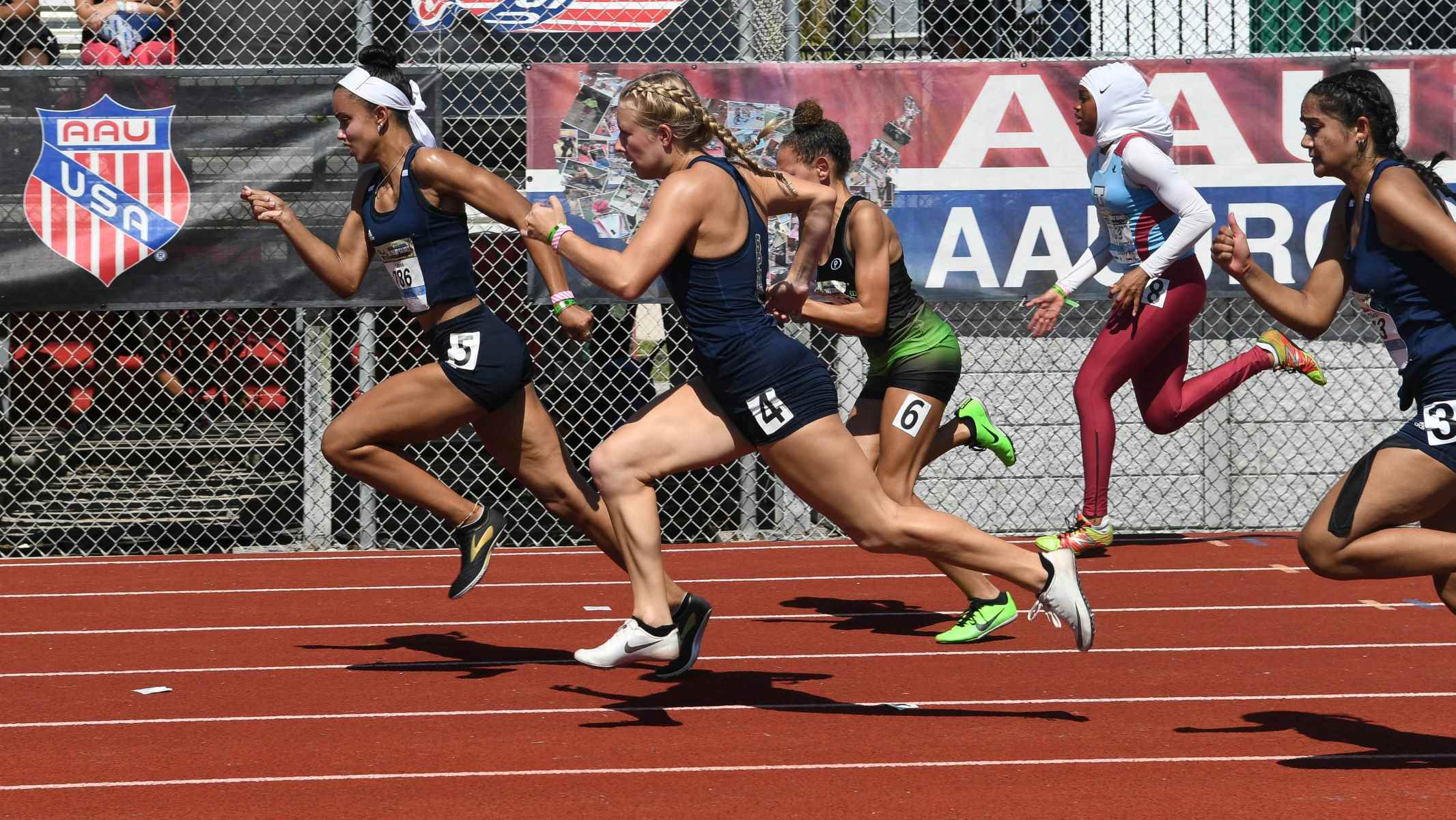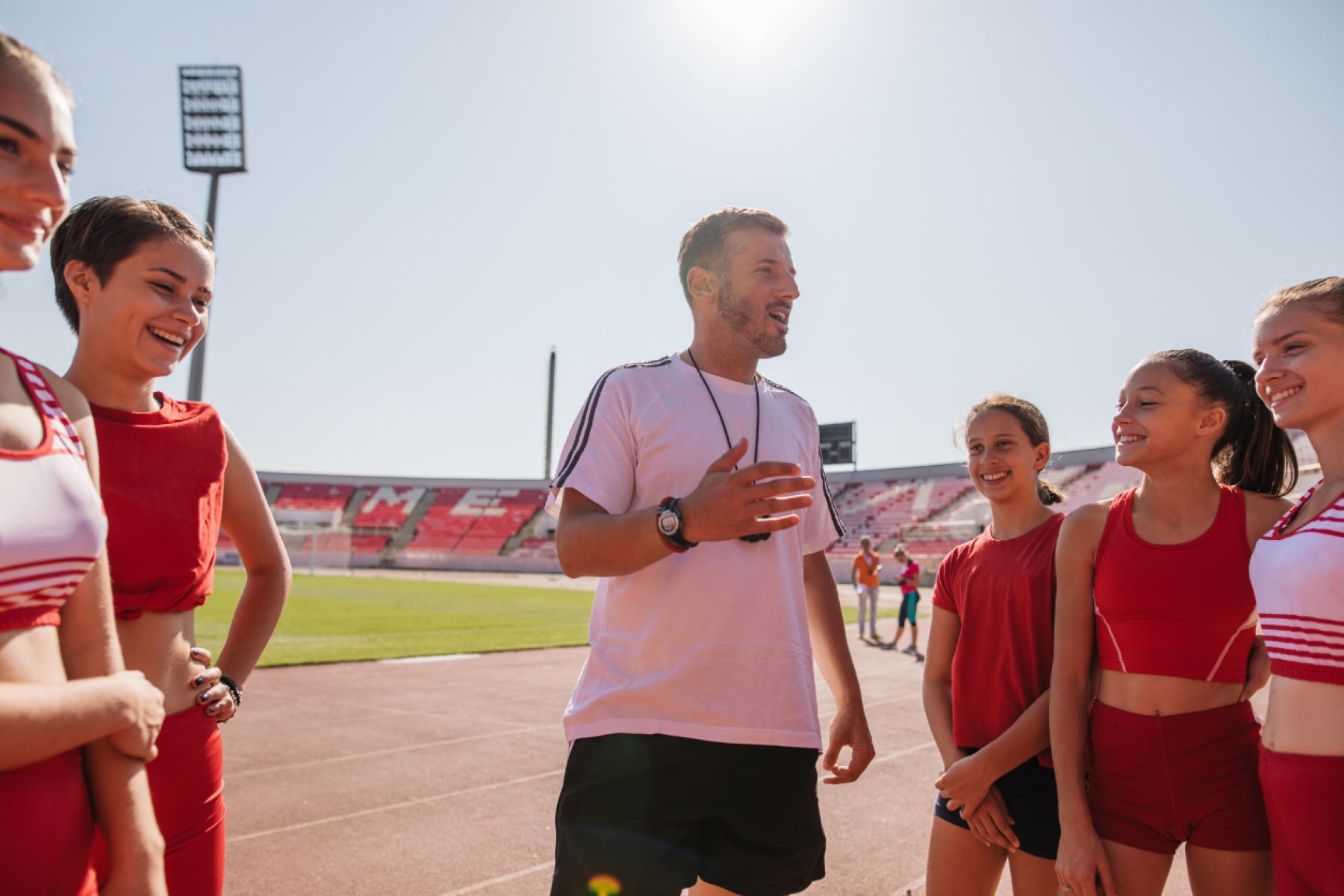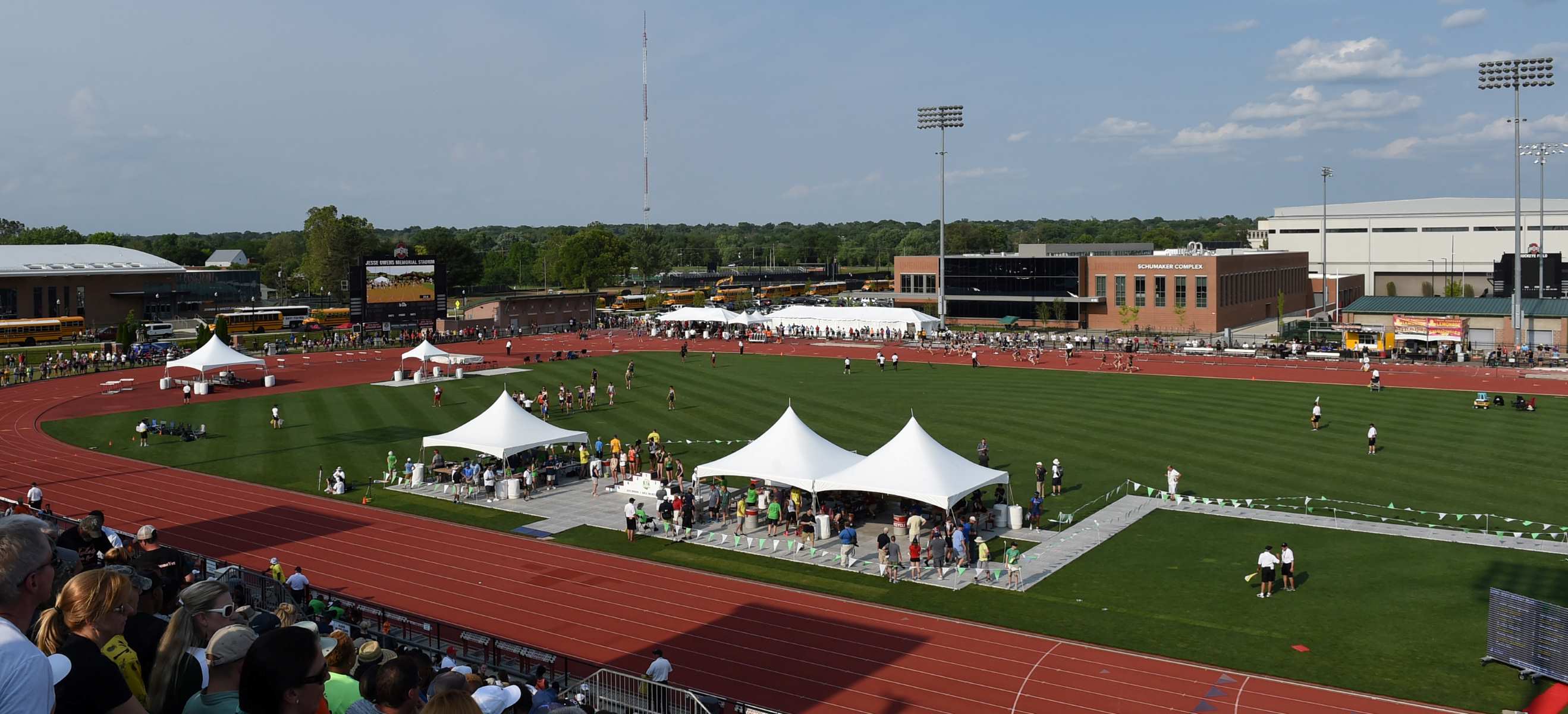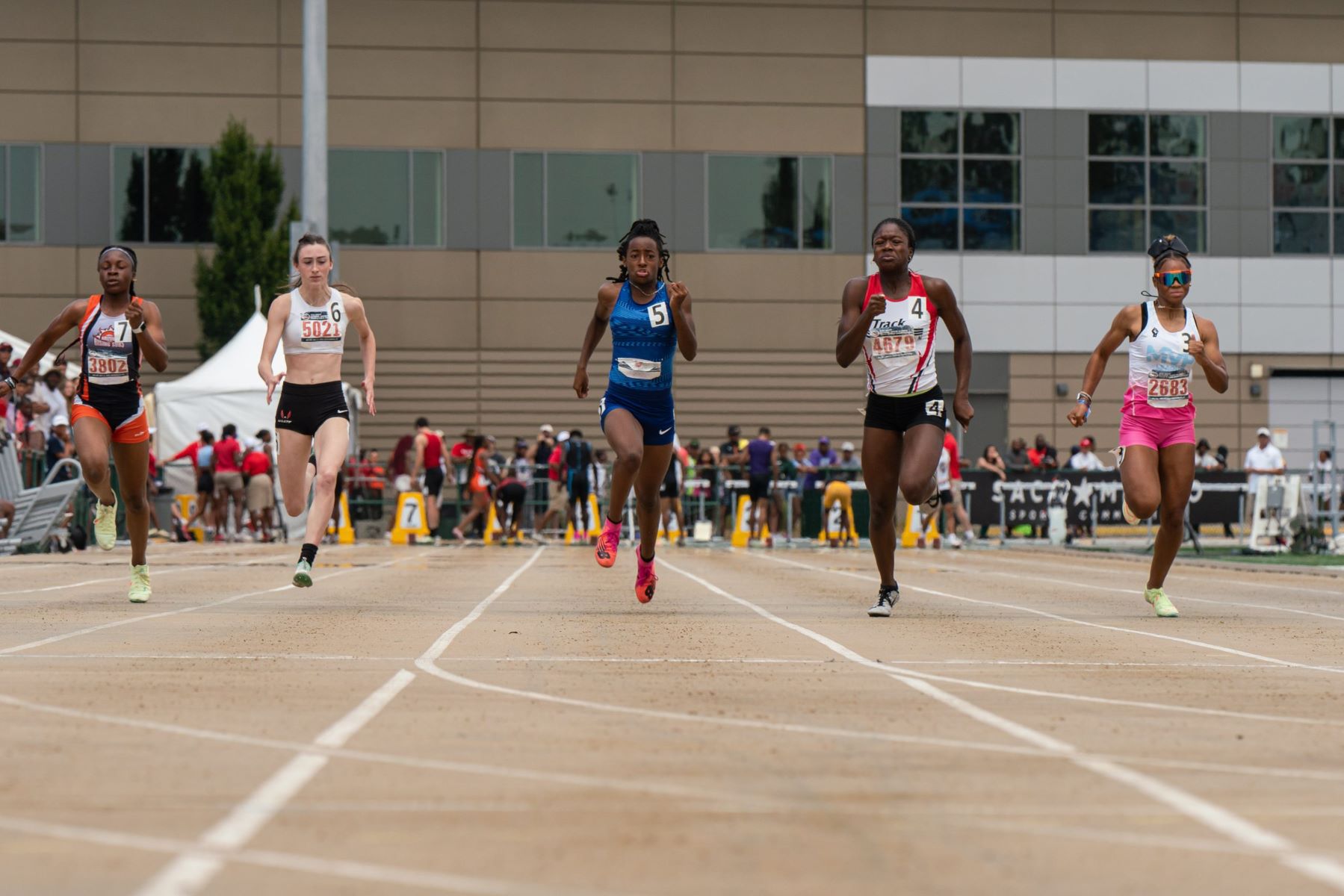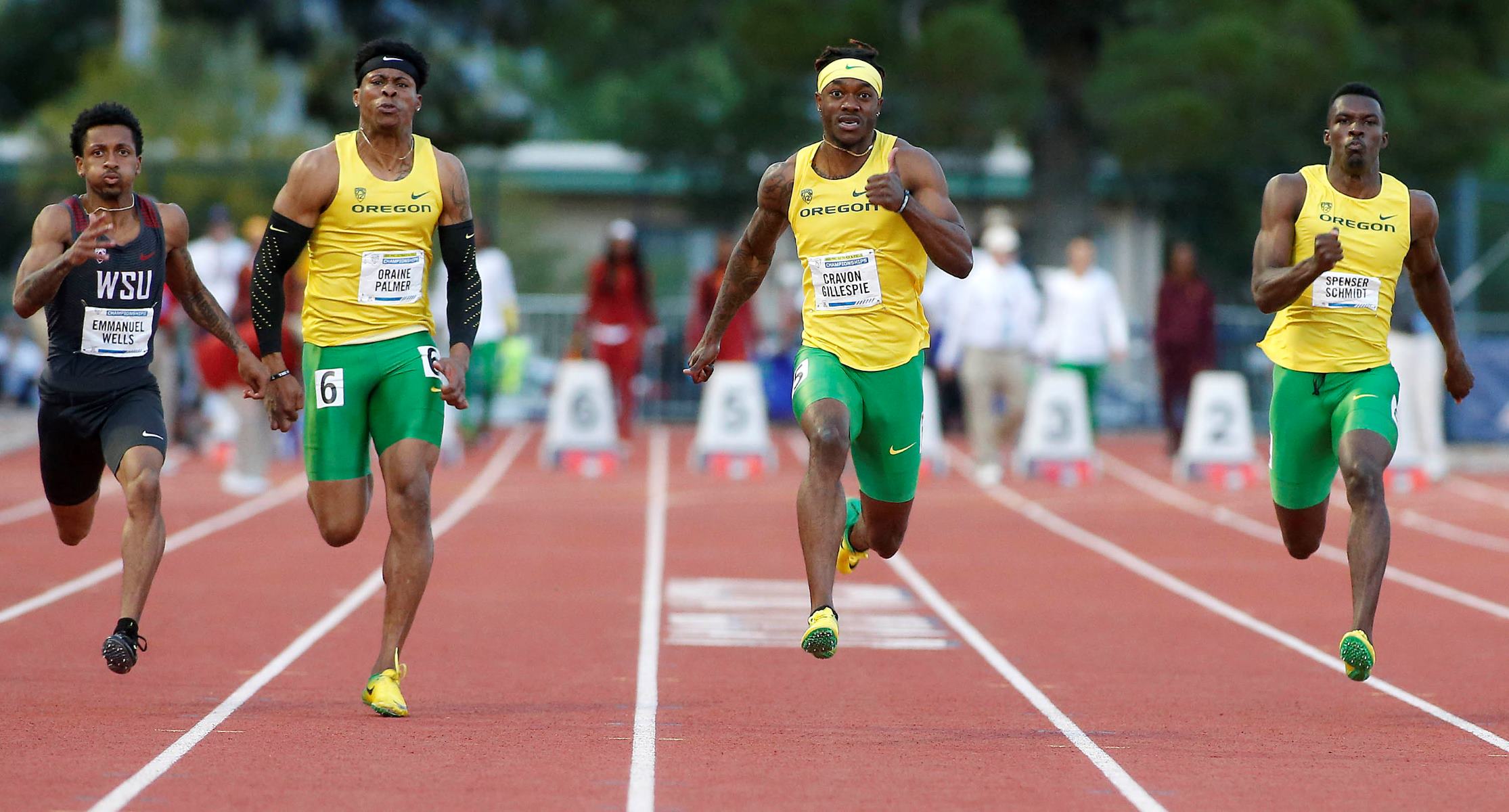Home>Misc>Featured>How To Join Track And Field In High School
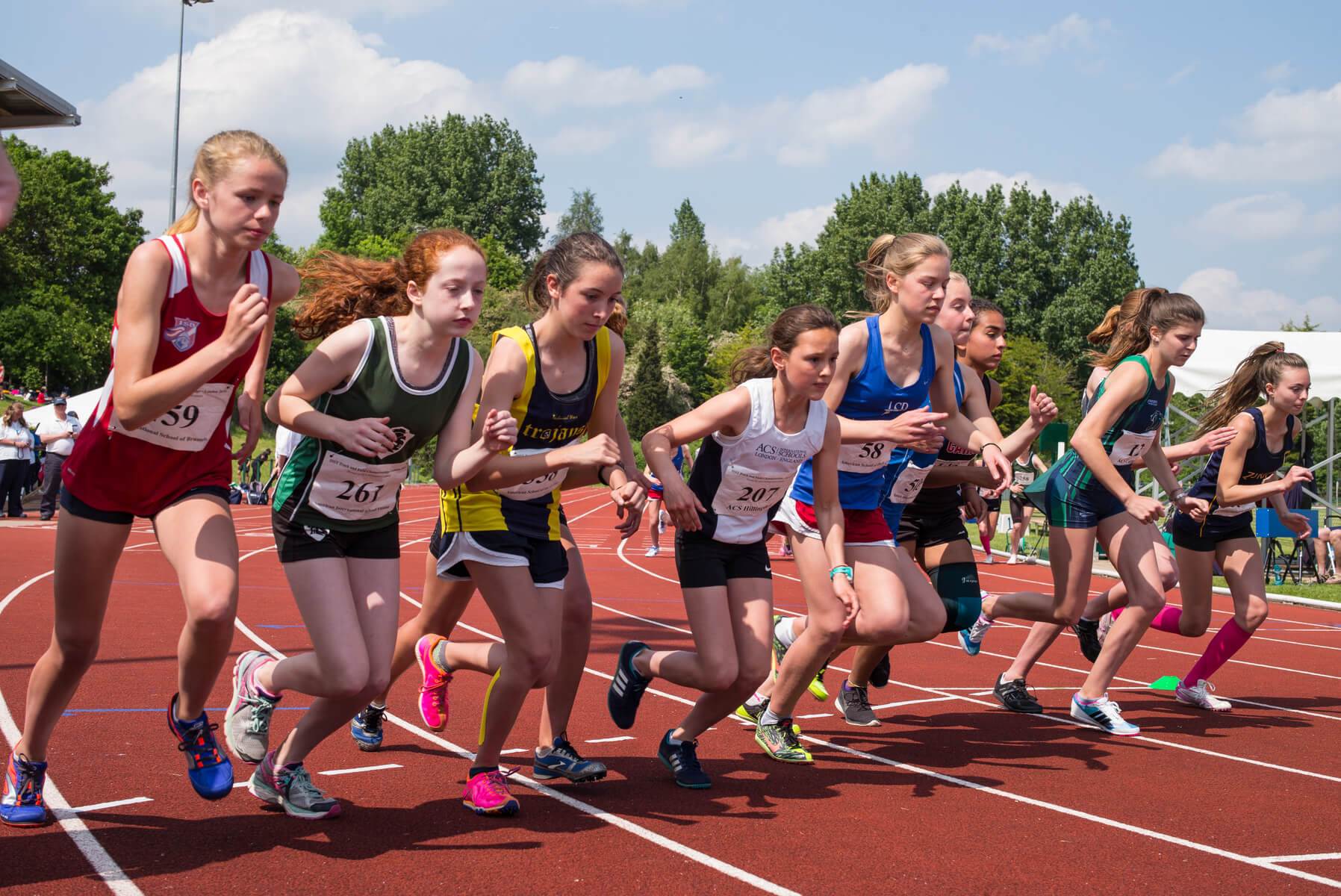

Featured
How To Join Track And Field In High School
Modified: January 2, 2024
Learn how to join track and field in high school with our featured guide. Discover the necessary steps and tips to become a part of this exciting sport.
Introduction
Welcome to the world of high school track and field, where speed, strength, and determination thrive. If you are considering joining a high school track and field team, you have made a wise choice. This exciting sport offers numerous benefits and opportunities for personal growth and achievement.
Track and field is a versatile sport that encompasses a wide range of events, including sprints, distance running, jumps, throws, and relays. It is not only a great way to stay active and improve your fitness, but it also allows you to compete against other schools and showcase your athletic abilities.
Being a part of a track and field team can have a positive impact on your overall high school experience. It provides a platform for you to make new friends, develop valuable skills, and learn important life lessons such as discipline, perseverance, and teamwork.
Whether you are a seasoned athlete or a beginner, track and field offers something for everyone. You don’t need to have prior experience in a specific event to join a team; coaches will guide you in discovering your strengths and help you improve in your chosen events.
In this comprehensive guide, we will explore the benefits of joining track and field in high school, provide an overview of the different events, discuss the requirements and eligibility, offer tips on finding a team and preparing for tryouts, and delve into the importance of proper nutrition and hydration for track and field athletes. We will also discuss the significance of balancing academics with your athletics commitments and address the opportunities for scholarships in track and field.
So, if you are ready to embark on an incredible journey of athleticism and personal growth, let’s dive into the exciting world of high school track and field!
Benefits of Joining Track and Field in High School
Joining a track and field team in high school offers numerous benefits that extend beyond the track itself. Here are some of the main advantages of being part of a track and field team:
- Improved Physical Fitness: Track and field is a demanding sport that requires strength, speed, endurance, and agility. By participating in regular training and competitions, you will enhance your overall fitness level and improve your cardiovascular health.
- Opportunity for Personal Growth: Track and field challenges you both mentally and physically. As you set goals, work towards them, and see improvement, you will develop a sense of self-discipline, perseverance, and determination that will benefit you in all areas of life.
- Enhanced Athletic Skills: Track and field offers a wide range of events, allowing you to explore different areas and discover your strengths. Whether you excel in sprints, long jump, discus, or any other event, you will have the opportunity to refine your skills and compete against other athletes.
- Teamwork and camaraderie: While track and field is primarily an individual sport, being part of a team fosters a sense of camaraderie and support. You will have the chance to train together, cheer each other on during competitions, and build lasting friendships.
- College and Scholarship Opportunities: If you excel in track and field, it can open doors to college scholarships and opportunities to compete at the collegiate level. Colleges often offer athletic scholarships for track and field athletes, providing financial assistance for your education.
- Improved Time Management Skills: Balancing academics and athletics can be a challenging task, but participating in track and field teaches you valuable time management skills. You will learn to prioritize your commitments, manage your schedule efficiently, and develop discipline in meeting deadlines.
- Mental and Emotional Benefits: Engaging in physical activity, such as track and field, releases endorphins and promotes mental well-being. It can help reduce stress, boost your mood, and improve your overall mental health.
- Individual Growth and Confidence: Track and field allows you to challenge yourself, set personal goals, and see your progress over time. As you achieve your goals and witness improvements in your performance, your confidence will soar both on and off the track.
As you can see, joining a track and field team in high school offers a multitude of benefits that extend beyond the sport itself. It is an opportunity for personal growth, physical fitness, and social connections that will stay with you for a lifetime.
Understanding the Different Track and Field Events
Track and field is a sport that encompasses a wide range of events, each with its own unique challenges and requirements. Understanding these events and their specific characteristics can help you choose the events you want to specialize in and prepare accordingly. Here are some of the main track and field events:
- Sprints: Sprints are short-distance races, usually ranging from 100 meters to 400 meters. These events require explosive speed and power, as athletes strive to cover the designated distance in the shortest time possible.
- Long-Distance Running: Long-distance running events include races such as the 800 meters, 1500 meters, 3000 meters, and more. These events require a combination of endurance, pacing, and strategic racing tactics.
- Hurdles: Hurdles events involve running and leaping over a series of hurdles placed at set distances. Athletes must maintain speed while clearing each hurdle without knocking them down.
- Relays: Relays involve a team of four athletes who take turns running a designated distance, typically 4×100 meters or 4×400 meters. The smooth exchange of the baton between teammates is crucial for a successful relay.
- Throwing Events: Throwing events include shot put, discus, javelin, and hammer throw. These events require strength, technique, and explosive power, as athletes throw the respective implement as far as possible.
- Jumping Events: Jumping events consist of long jump, triple jump, high jump, and pole vault. Athletes aim to achieve the greatest distance or height by utilizing proper technique and explosive power.
- Combined Events: Combined events, also known as multi-events, include heptathlon (women) and decathlon (men). Athletes compete in a series of track and field events over multiple days, accumulating points based on their performance in each event.
It is important to note that each event requires specific skills, techniques, and training methods. If you are new to track and field, it is recommended to try out different events during practice sessions to discover which ones suit you best. Coaches can provide guidance and help you develop the necessary skills and techniques for your chosen events.
By understanding the different track and field events, you can plan your training effectively, set appropriate goals, and enjoy the process of honing your skills in the events that align with your strengths and interests.
Requirements and Eligibility
Joining a high school track and field team comes with certain requirements and eligibility criteria that you must meet. While specific rules may vary depending on your school or district, here are some general guidelines to consider:
- Academic Eligibility: In most cases, student-athletes must maintain a certain GPA and meet academic standards to participate in sports. You may need to maintain a minimum grade point average and have no failing grades to be eligible for the team.
- Physical Examination: Before participating in any sports, including track and field, you may be required to undergo a physical examination. This ensures that you are in good health and capable of safely participating in athletic activities.
- Parental Consent: If you are under the age of 18, you will typically need to obtain parental or guardian consent to participate in track and field. This consent may be required annually or for each specific season.
- Attendance and Behavior: Schools often have requirements regarding attendance and behavior for student-athletes. You may be expected to maintain good attendance in both school and practice, and adhere to a code of conduct that promotes positive behavior and sportsmanship.
- Tryouts: In some cases, track and field teams may hold tryouts to evaluate potential athletes and determine team placement. Tryouts typically involve demonstrating your skills, speed, and abilities in specific events.
It is essential to consult with your school’s athletic department, coach, or track and field coordinator to understand the specific requirements and eligibility criteria that apply to you. They will provide you with the necessary forms, information on physical examinations, and any additional documentation required.
Remember, track and field welcomes athletes of all levels, from beginners to experienced competitors. If you meet the eligibility criteria and have the passion and determination to excel in the sport, don’t hesitate to join your high school track and field team and embark on an exciting athletic journey.
Finding a Track and Field Team
When it comes to finding a track and field team to join, there are several avenues you can explore. Here are some tips to help you find the right track and field team for you:
- Talk to Your School’s Athletic Department: Start by reaching out to your school’s athletic department or physical education department. They will have information about the track and field team and can guide you on how to get involved.
- Attend School Sports Fairs and Information Sessions: Many schools hold sports fairs or information sessions at the beginning of the school year. These events provide an opportunity for you to learn about the different sports teams, including track and field.
- Contact the Track and Field Coach: Reach out to the track and field coach at your school. They can provide you with detailed information about the team, practice schedules, and any tryout requirements.
- Connect with Current Team Members: If you know any current track and field team members, talk to them about their experience and ask for advice on joining the team. They can offer insights into the team dynamics, training, and what to expect.
- Research Outside Track Clubs: In addition to school teams, there might be local track clubs or organizations in your community. These clubs often offer training and competitive opportunities outside of the school season.
- Utilize Online Resources: Use online resources such as school websites, athletic directories, and social media platforms to gather information about track and field teams in your area. These resources can provide insights into team achievements, coaching staff, and contact information.
- Attend Track Meets: Attend track meets held at your school or in your community. This will allow you to watch the events, see the teams in action, and potentially speak to athletes or coaches to gain more information.
Remember that joining a track and field team requires commitment and dedication. Consider the team’s culture, coaching philosophy, and training approach when making your decision. Find a team that aligns with your goals, values, and provides a supportive and encouraging environment for your growth as an athlete.
Once you have identified a track and field team, reach out to the coach or team captain for more information on how to get started. They will guide you through the registration process, provide details on upcoming tryouts or practices, and assist you in becoming a part of the team.
Preparing for Tryouts and Training
Preparing for tryouts and training in track and field is crucial to ensure you are ready to perform at your best. Here are some tips to help you prepare effectively:
- Get in Shape: Engage in regular physical activity to build your general fitness level. Incorporate cardio exercises, strength training, and flexibility exercises into your routine to improve your overall athletic abilities.
- Focus on Event-Specific Training: Identify the track and field events you want to participate in and tailor your training accordingly. Work on specific skills, techniques, and endurance required for your chosen events.
- Practice Proper Running Form: Good running form is essential in track and field. Work on your posture, arm swing, leg drive, and footstrike to improve your efficiency and reduce the risk of injuries.
- Train for Speed and Agility: Incorporate speed and agility drills into your training routine. This will help improve your acceleration, quickness, and change of direction, which are crucial in many track and field events.
- Develop Strength and Power: Strength training is important in track and field to enhance performance and prevent injury. Focus on exercises that target the muscles used in your specific events, such as lunges, squats, and plyometric exercises.
- Work on Event-Specific Skills: Practice the specific skills required for your chosen events. This may include practicing starts for sprints, working on hurdle technique, or refining your throwing or jumping techniques.
- Improve Endurance: Track and field events can be physically demanding, so building your endurance is crucial. Incorporate steady-state runs, interval training, and tempo runs into your training to improve your stamina.
- Stay Consistent and Dedicated: Consistency is key in track and field. Be committed to your training and make it a priority. Set aside dedicated time for practice and stay disciplined in sticking to your training plan.
- Focus on Rest and Recovery: Allow your body time to rest and recover between training sessions. Get enough sleep, eat a healthy diet, and listen to your body to avoid overtraining and reduce the risk of injuries.
- Prepare Mentally: Mental preparation is just as important as physical training. Visualize success, set goals, and maintain a positive mindset. Build mental toughness and focus through mental exercises and visualization techniques.
Remember, track and field is a sport that requires time and effort to excel. Stay committed, be patient with your progress, and trust in your training. With the right preparation and dedication, you’ll be ready to showcase your skills and make a strong impression during tryouts and training.
Equipment and Apparel Needed for Track and Field
When participating in track and field, having the right equipment and apparel is essential for optimal performance and comfort. Here are some key items you will need:
- Running Shoes: Invest in a good pair of running shoes that provide proper support, cushioning, and traction. Choose shoes specific to your event, whether it’s for sprints, long-distance running, or jumps.
- Spikes: Spikes are essential for sprinters and middle-distance runners. They provide added traction and help improve acceleration and stability. Make sure to check the rules and regulations of your events or competitions regarding spike length.
- Apparel: Wear lightweight, moisture-wicking clothing that allows for a full range of motion. Opt for shorts or leggings, a comfortable top, and proper undergarments. Consider weather conditions and choose layers accordingly for warmth or sun protection.
- Compression Gear: Compression sleeves, socks, or tights can aid in muscle support, reduce fatigue, and improve blood circulation during training and competitions.
- Throwing Implements: If you plan to participate in throwing events such as shot put, discus, javelin, or hammer throw, you will need the specific implements for each event. These implements are typically provided by your school or training facility.
- Jumping Equipment: For jumping events such as long jump, triple jump, and high jump, you may need certain equipment such as a take-off board, landing pit, or high jump bar. These are typically provided at competition venues.
- Accessories: Consider using accessories like wristbands, headbands, or sunglasses for added comfort and protection against sweat and sun glare.
- Water Bottle and Hydration: Stay hydrated during training and competitions by carrying a water bottle with you. Hydration is crucial for optimal performance and to prevent dehydration during intense workouts.
- Timing Device: If you are training on your own or want to track your own times, a stopwatch or sports watch with timing capabilities can be useful.
- Equipment Bag: Invest in a durable and spacious equipment bag to carry all your track and field essentials. This will help you stay organized and ensure you have everything you need for practice and competitions.
It’s important to note that some equipment, such as throwing implements and jumping equipment, may be provided by your school or training facility. However, if you plan to train on your own, it may be beneficial to invest in your own equipment as you progress in the sport.
Ultimately, having the right equipment and apparel will enhance your performance, keep you comfortable, and minimize the risk of injuries. Consult with your coach or experienced athletes for specific recommendations based on your event and training needs.
Developing Skills and Techniques in Track and Field
Track and field requires a combination of physical prowess, technical proficiency, and strategic execution. Developing skills and techniques specific to your chosen events is crucial for success. Here are some key aspects to focus on when honing your skills in track and field:
- Starts and Acceleration: For sprinters, mastering the start and acceleration phase is vital. Practice explosive starts, efficient block placement, and driving your knees for maximum speed out of the blocks.
- Running Form: Proper running form is essential in track and field. Work on maintaining an upright body posture, relaxed shoulders, a slight forward lean, and driving your arms and knees with each stride.
- Hurdle Technique: If participating in hurdles, focus on perfecting your technique. Practice proper stride patterns, maintaining a smooth and efficient rhythm, and clearing each hurdle with precision.
- Throws Technique: Develop proper throwing technique for shot put, discus, javelin, or hammer throw. Focus on footwork, hip rotation, arm coordination, and follow-through to maximize distance and power.
- Jumping Technique: For jumping events, such as long jump, triple jump, or high jump, work on mastering the techniques specific to each event. Proper take-off, timing, and coordination are essential for achieving maximum height and distance.
- Relay Exchanges: If participating in relays, practice smooth and efficient baton exchanges with your teammates. Focus on timing, communication, and maintaining speed throughout the exchange zones.
- Endurance and Pace: Develop strategies to improve endurance and pacing for long-distance events. Practice interval training, tempo runs, and race simulations to build your stamina and maintain an optimal race pace.
- Strength and Power: Incorporate strength and power training into your regimen to improve overall athleticism and performance. Focus on exercises that target muscle groups used in your specific events, such as squats, lunges, and plyometrics.
- Coordination and Agility: Enhance your coordination and agility through drills and exercises that challenge your balance, footwork, and quick reaction times. Agility ladder drills, cone drills, and other agility exercises can be beneficial.
- Video Analysis: Use video analysis tools to study and analyze your technique. Record your performances or training sessions and review them with your coach to identify areas for improvement and make necessary adjustments.
Consistency and feedback from your coach are crucial as you work on developing skills and techniques in track and field. Focus on quality training, seek guidance from experienced coaches, and engage in regular practice to refine your abilities.
Remember, mastering skills and techniques takes time and dedication. Stay patient, stay focused, and continue to refine your skills through consistent training and a commitment to improvement.
Importance of Nutrition and Hydration for Track and Field Athletes
Nutrition and hydration play a vital role in the performance and overall well-being of track and field athletes. Proper fueling and hydration can enhance energy levels, optimize performance, support recovery, and reduce the risk of injuries. Here’s why nutrition and hydration are essential for track and field athletes:
- Energy and Performance: Adequate fueling is crucial to meet the energy demands of track and field training and competitions. Carbohydrates are the primary source of energy for high-intensity activities, so include sources like whole grains, fruits, and starchy vegetables in your diet.
- Muscle Recovery and Repair: Consuming an adequate amount of protein is essential for muscle recovery and repair. Include lean sources of protein such as poultry, fish, eggs, dairy, legumes, and tofu in your meals and snacks to support muscle growth and repair.
- Hydration: Staying properly hydrated is essential to maintain performance and prevent dehydration. Drink water throughout the day and consider sports drinks if you’re engaging in intense workouts to replenish electrolytes lost through sweat.
- Electrolyte Balance: Electrolytes, such as sodium, potassium, and magnesium, play a crucial role in muscle and nerve function. Consuming electrolyte-rich foods and beverages, such as bananas, coconut water, and sports drinks, can help maintain electrolyte balance.
- Preventing Fatigue and Cramps: Adequate nutrition and hydration can help prevent fatigue and muscle cramps during training and competitions. Ensure you consume a balanced diet that includes a variety of nutrients, such as vitamins and minerals, to support overall health and performance.
- Meal Timing: Timing your meals and snacks strategically can optimize energy levels and prevent digestive discomfort during training and competitions. Eat a balanced meal or snack 1-3 hours before exercise and consume a post-workout meal or snack within 30-60 minutes after training to optimize recovery.
- Weight Management: Proper nutrition plays a role in maintaining a healthy body weight and body composition. Consult with a sports dietitian or nutritionist to determine the right balance of macronutrients for your individual goals and needs.
- Immunity and Injury Prevention: Proper nutrition supports a strong immune system and aids in injury prevention. A diet rich in fruits, vegetables, whole grains, lean proteins, and healthy fats provides essential vitamins, minerals, and antioxidants that promote immune health and tissue repair.
- Mental Focus: Good nutrition influences mental clarity and focus. Consuming a balanced diet that includes adequate nutrients, such as omega-3 fatty acids and B vitamins, supports cognitive function, which is crucial for mental focus and concentration during training and competitions.
Remember, every athlete is unique, and individual nutrition needs may vary. It’s important to work with a sports dietitian or nutritionist who can provide personalized guidance based on your specific needs, goals, and dietary restrictions.
By prioritizing proper nutrition and hydration, track and field athletes can optimize their performance, enhance recovery, and maintain long-term health and well-being.
Balancing Academics and Athletics in High School Track and Field
Participating in high school track and field requires effective time management and the ability to balance academic responsibilities with athletic commitments. It may seem challenging at times, but with proper planning and organization, you can excel both on the track and in the classroom. Here are some strategies to help you find a balance:
- Create a Schedule: Develop a schedule that incorporates designated study time, practice sessions, and competition days. Having a structured plan will help you allocate time for both academics and athletics.
- Prioritize and Manage Your Time: Identify your most important tasks and prioritize them. Learn to manage your time effectively, setting aside dedicated study periods and optimizing pockets of time for studying, such as during lunch breaks or commuting.
- Utilize Study Strategies: Adopt effective study strategies, such as breaking down study materials into manageable chunks, using active learning techniques, and staying organized with thorough note-taking and task prioritization.
- Communicate and Collaborate: Maintain open lines of communication with teachers, coaches, and teammates. Let them know about your commitments and seek their support and understanding. Collaboration with classmates can also help with sharing notes and study materials.
- Maximize Study Efficiency: When time is limited, focus on high-yield study strategies. Review class notes, utilize online resources, and practice with past exams and quizzes to optimize your study sessions.
- Seek Help and Support: Don’t hesitate to seek help if you’re struggling with academics or finding the right balance. Reach out to teachers, academic advisors, or tutors for assistance and guidance.
- Stay Organized: Use tools such as calendars, to-do lists, and digital apps to stay organized and keep track of deadlines, assignments, and upcoming track events. Set reminders for important tasks and create a system that works for you.
- Take Care of Yourself: Remember to take care of your physical and mental well-being. Get enough sleep, eat nutritious meals, exercise regularly, and take breaks when needed. Self-care is important for maintaining focus and performance in both athletics and academics.
- Stay Committed to Your Goals: Remember your long-term goals and the reasons why you are participating in both track and field and academics. Use these as motivation to stay dedicated and persevere through challenges.
- Practice Time Management: Develop good time management skills by setting realistic goals, prioritizing tasks, and staying disciplined in adhering to your schedule. Avoid procrastination and make efficient use of your available time.
By finding the right balance between academics and athletics, you can excel in both areas. Remember, it’s important to be flexible and make adjustments as needed. With proper planning, organization, and prioritization, you can thrive in both your academic pursuits and your track and field endeavors.
Building Team Spirit and Camaraderie
Team spirit and camaraderie are essential components of a successful track and field team. Creating a positive team environment fosters support, unity, and a sense of belonging among teammates. Here are some strategies to build team spirit and camaraderie:
- Encourage Communication: Foster open and honest communication among team members. Create a culture where everyone feels comfortable sharing ideas, concerns, and aspirations.
- Team-Building Activities: Engage in team-building activities both on and off the track. These can include team lunches, bonding games, or organized outings. Participating in activities that encourage interaction and collaboration strengthens the bonds among teammates.
- Celebrate Each Other’s Successes: Recognize and celebrate individual and team achievements. Acknowledge and applaud each other’s progress, personal records, and milestones. This promotes a positive and uplifting team culture.
- Supportive Environment: Create a supportive environment where teammates rally behind each other. Offer words of encouragement during training and competitions, and provide constructive feedback to help each other improve.
- Inclusive Team Culture: Ensure that every member feels included and valued. Avoid cliques or favoritism. Foster a sense of belonging by promoting inclusivity and acceptance.
- Mutual Respect: Cultivate an environment of mutual respect among all team members. Embrace diversity, and encourage everyone to respect each other’s differences and viewpoints.
- Team Chants and Cheers: Develop unique team chants, cheers, or mottos that embody the team spirit. Encourage participation from everyone during competitions to foster a sense of unity and enthusiasm.
- Collaborative Team Activities: Engage in collaborative training exercises or drills that require teamwork. This can involve relay races, group circuits, or partner workouts. Collaboration fosters a sense of interdependence and strengthens bonds between teammates.
- Organize Social Events: Plan social events outside of regular practice and competitions. These could include team dinners, movie nights, or fundraising activities. Building camaraderie outside of the track allows teammates to connect on a personal level and develop deeper friendships.
- Lead by Example: Coaches and team captains should lead by example. Demonstrate the qualities of sportsmanship, camaraderie, and dedication that you expect from your team members.
Remember, building team spirit and camaraderie is an ongoing process. It requires effort from every team member to create a positive and supportive team culture. When teammates work together, support each other, and cultivate a strong sense of camaraderie, the team’s overall performance and enjoyment of the sport greatly improve.
Setting Personal Goals and Tracking Progress
Setting personal goals in track and field is essential for growth, motivation, and measuring progress. Whether you are a sprinter, thrower, jumper, or distance runner, having clear goals helps you stay focused and track your improvement over time. Here are some tips for setting personal goals and tracking your progress in track and field:
- Identify Your Motivation: Reflect on why you participate in track and field and what you hope to achieve. Set goals that align with your personal aspirations and values.
- Set Specific and Realistic Goals: Make your goals specific, measurable, attainable, relevant, and time-bound (SMART). Define what you want to achieve, the criteria for success, and a realistic timeline for accomplishing each goal.
- Focus on Performance and Process: Set goals that focus on performance and process rather than solely on outcome. For example, instead of setting a goal to win a certain race, focus on improving your personal best time or refining your technique.
- Break Down Goals: Break down your larger goals into smaller, manageable milestones. This allows you to track progress more effectively and provides a sense of achievement along the way.
- Create Action Plans: Develop action plans outlining the steps necessary to achieve your goals. Break each goal into specific actions and create a timeline for completing them.
- Regularly Assess and Evaluate: Continuously assess your progress and evaluate whether you are on track to achieve your goals. Regularly review and adjust your action plans as needed.
- Use Data and Technology: Utilize technology such as fitness trackers, timing devices, and mobile apps to track your performance, monitor your training, and gather data that can help you identify areas for improvement.
- Celebrate Milestones: Celebrate your achievements and milestones along the way. Recognize your progress, no matter how small, and use it as motivation to keep pushing forward.
- Seek Feedback: Seek feedback from your coach, teammates, and experienced athletes. Their input can provide valuable insights and guidance to help you refine your goals and training approach.
- Maintain a Positive Mindset: Stay positive and focused, even when faced with setbacks or challenges. Use obstacles as learning opportunities and let them fuel your determination to overcome them.
Remember, the journey in track and field is filled with ups and downs. Stay committed to your goals, stay disciplined in your training, and keep pushing yourself to reach new heights. By setting personal goals and tracking your progress, you can continuously improve and achieve your potential in track and field.
Opportunities for College Scholarships in Track and Field
Track and field offers numerous opportunities for high school athletes to secure college scholarships. College track and field programs actively recruit talented athletes who demonstrate exceptional skills and potential in their respective events. Here is an overview of the opportunities for college scholarships in track and field:
- NCAA Scholarships: The National Collegiate Athletic Association (NCAA) offers scholarships at both Division I and Division II levels. These scholarships cover tuition, room and board, books, and other expenses for student-athletes who meet the eligibility requirements and demonstrate outstanding athletic abilities.
- NAIA Scholarships: The National Association of Intercollegiate Athletics (NAIA) also offers scholarships to student-athletes, including track and field athletes. NAIA scholarships vary from school to school and can cover a significant portion of the student’s educational expenses.
- College Athletic Scholarships: Many colleges and universities, regardless of their NCAA or NAIA affiliation, offer their own athletic scholarships to track and field athletes. These scholarships can provide financial support to student-athletes based on their athletic abilities and potential contributions to the college’s track and field program.
- Recruitment Process: Getting noticed by college coaches is a critical part of securing track and field scholarships. Coaches often attend high school track meets, state championships, and national-level competitions to scout talented athletes. It’s essential to perform well during these events and actively reach out to coaches to express your interest in their programs.
- Building a Track Record: To enhance your chances of earning a track and field scholarship, focus on building a strong track record of achievements. Set personal records, win championships, and compete at a high level to demonstrate your talent and potential to college coaches.
- Academic Performance: Academic achievement is also a factor in earning track and field scholarships. Maintaining a strong GPA and demonstrating academic prowess can make you a more attractive candidate to college coaches and increase your chances of receiving academic and athletic scholarships.
- Highlighting Extracurricular Activities: In addition to track and field achievements, showcase your involvement in extracurricular activities, leadership roles, and community service. College coaches value well-rounded athletes who contribute to the overall campus community.
- Seeking Guidance: Work closely with your high school track coach and guidance counselors to navigate the scholarship process. They can provide valuable advice, help you create an athletic resume, and assist with contacting college coaches.
- Attending Camps and Showcases: Participate in camps, clinics, and showcases specifically designed for track and field athletes. These events provide opportunities to showcase your skills in front of college coaches and gain exposure.
- Applying for Financial Aid: Understand that the scholarship process can be competitive. In addition to athletic scholarships, applying for need-based financial aid and academic scholarships can help alleviate the financial burden of college expenses.
Remember, securing a track and field scholarship requires dedication, talent, and proactive engagement in the college recruitment process. Research scholarship opportunities, keep your academic performance strong, seek guidance, and stay committed to your athletic development. With the right approach, you can increase your chances of earning a track and field scholarship and pursue your passion for the sport at the collegiate level.
Conclusion
Joining a high school track and field team offers a myriad of benefits, from improved physical fitness and personal growth to the opportunity to showcase your skills and compete at the collegiate level. Understanding the different track and field events, meeting the requirements and eligibility criteria, and finding the right team are crucial steps in starting your track and field journey.
As you embark on this athletic endeavor, remember the significance of nutrition and hydration for optimal performance and recovery. Balancing academics with athletics requires effective time management, organization, and communication. Building team spirit and camaraderie fosters a positive and supportive environment, enhancing the overall experience for you and your teammates.
Setting personal goals, tracking progress, and seizing opportunities for college scholarships in track and field will propel you towards achieving your athletic and educational aspirations. Whether you excel in sprints, long-distance running, throws, jumps, or multi-events, staying committed and disciplined is key to reaching your full potential.
As you navigate the world of high school track and field, never forget the value of teamwork, determination, and resilience. Embrace each practice, each race, and each challenge with passion and dedication. Track and field is not just a sport; it is a journey of self-discovery, growth, and achievement.
So, lace up your shoes, step onto the track, and let the exhilarating world of high school track and field propel you towards success and unforgettable experiences.

